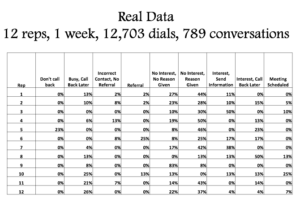
Coach by the Numbers, Part 4
To conclude this four-part blog series on coaching, here’s a step-by-step guide for using the “Coach by the Numbers” process to get each representative on your sales development team up to an optimal level of cold-calling success.
- Get rigorous about creating a list of call dispositions that work for coaching. This is actually the only hard step. The recipe is to standardize a set of dispositions that, pure and simple, tell you what happened in the conversation. Some managers and teams are tempted to throw in some dispositions that are really recommendations, or predictions, or a set of switches that say “Do this next.” At the other end of the spectrum, some dispositions are simply too general, such as “Spoke with Contact,” which tells you exactly nothing about what happened inside the conversation and, therefore, exactly nothing about what needs to be improved. The set of dispositions in the table below (introduced in Part 2 of this blog series) is a good starting point. For most teams, it’s probably not a bad ending point either.
| Call Disposition | Conversation Phase |
| Hung Up (OR Don’t Call Back) | Open and Engage |
| Busy – Call Back | Open and Engage |
| Incorrect Contact – No Referral | Qualify Buying Role |
| Incorrect Contact – Referral | Qualify Buying Role |
| Not Interested – No Reason Given | Qualify Need and Timing |
| Not Interested – Reason Given | Qualify Need and Timing |
| Interested – Send Information | Qualify Need and Timing |
| Interested – Call Back Later | Qualify Need and Timing |
| Meeting Scheduled | Agree and Collaborate on Next Step |
- Get even more rigorous about making sure EVERY member of the team knows what each call disposition means and when to select it as the accurate description of a call’s outcome. And even more importantly, make sure they know when NOT to use each disposition. I have seen reps disposition a call as “Busy – Call Back” after a five-minute conversation. Really? Given the average sales development conversation runs about 1:08 (that’s one minute and eight seconds, not one hour and eight minutes!), a five-minute leisurely chat hardly deserves a “Busy – Call Back.” Unfortunately, the step of having each rep accurately summarize the outcome of each call takes time, commitment, and management attention — and probably even a regular, quality audit, with consequences. Staying away from fancy dispositions removes the excuses, but some reps just don’t see dispositioning calls accurately as part of their job. As management, you need to fix that, or bad data will overwhelm good intentions.
- Wait until you have enough accurately dispositioned conversations to serve as a foundation for coaching. You must start the clock only after you are sure that almost every conversation is being dispositioned the same way by almost every rep. Waiting is hard, especially for people in sales. But coaching based on meaningless data is both ineffective and inefficient, so wait you must. How long? For about 100 conversations per rep. These must be real conversations with prospective buyers. Voice mails and chats with gatekeepers don’t count. If you are using ConnectAndSell, you will probably have to wait for about one week, which is OK, because the final unit of measurement is “Meetings Set Per Week.” If your reps are spending their days navigating phone systems and hanging up on voicemails or, worse, repeatedly leaving voice messages, you may have to wait for a month or more. (I would apologize for this, but given that I am happy to provide you with the “one week” option, I won’t.)
- Extract a spreadsheet of all these dispositions. Your spreadsheet should contain one row per rep, and one column per disposition, with the columns in the same order as the table above, starting with “Don’t Call Back” and ending with “Meeting Scheduled.”

- Starting with the first disposition (Don’t Call Back), sort the spreadsheet in descending order by percentage numbers in that column only.
- Focusing only on this phase of the conversation, assess each rep’s performance. Coach the rep with the highest percentage, with the goal of bringing that rep’s performance to the level of the best performer, i.e., the rep at the “good” end of the sorted disposition data — the lowest percentage of calls with this disposition.
- Then, coach the next best rep for the same call outcome. Continue in order until all reps are performing at the benchmark goal set by the best rep for that particular disposition.
- Proceed to the next disposition, again sorting by the percentage numbers, and then coaching each rep to achieve the level of performance of the rep who has done best in that category. Be aware that a low percentage is the best result in the first five disposition categories, but for the last four disposition categories, a high percentage is the best result.
When your coaching has taken every rep up to the level of the best rep in each of the possible outcomes of a cold-calling conversation, you have an optimally performing sales development team. Take a break!
Link to the other three parts of this four-part blog: Part 1, Part 2, and Part 3.

